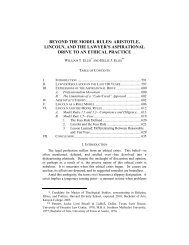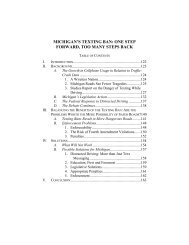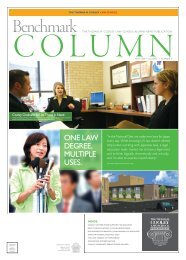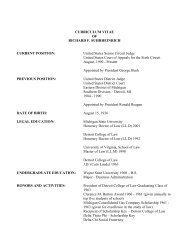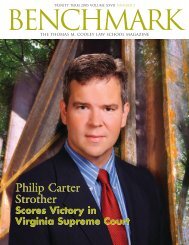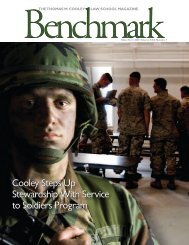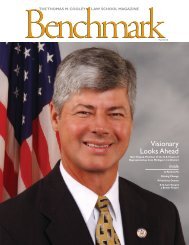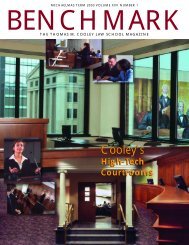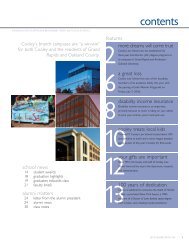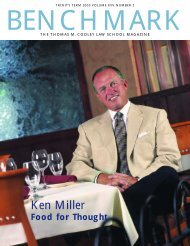FeatureJustice <strong>Cooley</strong>’s<strong>Law</strong> <strong>School</strong>:Legal Education for TodayThrough the Eyes of the 19thCentury’s Greatest <strong>Law</strong>yer.By Professor and Assistant Dean Nelson MillerIt is not hard to defendthe claim that the law school’snamesake <strong>Thomas</strong> McIntyre<strong>Cooley</strong> was the 19th Century’s greatest lawyer.<strong>Thomas</strong> <strong>Cooley</strong> worked his father’s farm in upperNew York until age 19 when he followed thousandsof others along the Erie Canal into theMidwestern heartlands. He settled in Michigan in1843, apprenticing and then practicing as a smalltown lawyer, where his hard work and publicspirit soon earned him the thankless task of compilingthe state’s statute. Things being what theyare, however (with great ends often starting fromhard work and humble beginnings), when it cametime to start the state’s first law school, who betterto serve as its first dean than the law compiler<strong>Thomas</strong> <strong>Cooley</strong> — who, not incidentally, was theonly candidate willing to move to Ann Arbor.Hard-won habits are not easily cast aside. As theUniversity of Michigan <strong>Law</strong> <strong>School</strong>’s dean from1858 until 1883, <strong>Thomas</strong> <strong>Cooley</strong> just kept onworking. In addition to acting as the officialreporter for decisions of the Michigan SupremeCourt, he wrote and revised treatises in severaldifferent areas of the law, each a classic of itstime used widely in the proliferating new lawschools: <strong>Cooley</strong> on Torts covering the breadth oftort law; <strong>Cooley</strong>’s Blackstone introducing andannotating the great law commentator’s epicwork; The <strong>Law</strong> of Taxation; a revised edition ofStory’s Commentaries on the Constitution; and hisown richly detailedcomparative work ConstitutionalLimitations, which for 20 years scholarsadmired as the best law book available. It is saidthat the United States Supreme Court has cited<strong>Thomas</strong> <strong>Cooley</strong> more than any other writer.His law students, though, admired him not for hisprofundity but for the clarity of his lectures, hiskindness, and his accessibility. The most celebratededucator of the age called <strong>Thomas</strong> <strong>Cooley</strong> themost lucid lecturer he had ever heard. Studentsalso appreciated <strong>Thomas</strong> <strong>Cooley</strong> for his design ofthe law school curriculum, which was short, practical,and flexible, so as to quickly and inexpensivelyequip each student with the particular skillsthey needed to return to their communities toserve a common-sense, ordered justice. And theyadmired <strong>Thomas</strong> <strong>Cooley</strong>’s law school for beingopen to anyone age 18, of good moral character,and literate in English — including African-Americans and including 80 students who camefrom Japan with the first opening of that secretiveempire. For a time <strong>Cooley</strong>’s law school was thelargest in the nation.It is not hard to imagine how <strong>Thomas</strong> <strong>Cooley</strong> wasable to turn his populist roots, work ethic, lawcompiling, and academic respect into the electedMichigan Supreme Court seat he held for 20
It has been my fortune to be to some extent in variousways a teacher of the law.years from 1865 to 1885. Justice <strong>Cooley</strong> earned furthernational recognition and respect while on that bench, for hissearch for order and respect for law in an enormously tumultuoustime. Indeed when in 1886 Harvard University commemoratedits 250th anniversary, to whom better to turn tolend prestige to the event by the granting of an honorarydegree, than the unparalleled Justice <strong>Cooley</strong>? It is said thatthe only reason he never reached the United States SupremeCourt was that he was not sufficiently political to capture theappointment.His career though was not over yet. In 1888, PresidentCleveland appointed the retired and acceptably apoliticalJustice <strong>Cooley</strong> to the nation’s first independent administrativeagency, the Interstate Commerce Commission, which promptlymade <strong>Cooley</strong> its first chair. He is today credited with havinginspired much of modern administrative law from thatpost. Though his Commission had no power (not even thesubpoena), Justice <strong>Cooley</strong>’s clear and accessiblefederal regulations adopted by fair procedures,together with his personal preaching, won sufficientrespect and compliance from the railroadbarons as to make a critical difference in an eraof competitive and labor turmoil. Justice <strong>Cooley</strong>’scareer ended with his election to president of theAmerican Bar Association.Anyone who would know the personal side ofJustice <strong>Cooley</strong> would want to know at least twoof his influences: President Andrew Jackson,whose populist Democratic politics dominatedthe hard scrabble country <strong>Thomas</strong> <strong>Cooley</strong> hadleft for the Michigan wilderness, and the 19thCentury’s great lawyer-evangelist Charles Finney. Thoughofficially first a Free Soiler and then a Republican inMichigan, <strong>Thomas</strong> <strong>Cooley</strong> was a Barnburner and JacksonianDemocrat at heart, concerned most with peace and prosperityfor the working family. As a consequence, he would belabeled both a conservative and a liberal and his writingsused by both. He was also unquestionably influenced byFinney’s relentlessly rational exposition of Christian truth andmoral responsibility, spurring the abolition of slavery, thegrant of suffrage, the end of child labor, and other socialand economic reform.Anyone who would know the professional side of Justice<strong>Cooley</strong> would want to know at least two of his influences: thegreat commentator William Blackstone, and the extraordinaryGerman-American law professor Francis Lieber.Blackstone’s substantive natural law scholarship (reflected soperfectly in the Declaration of Independence) was law’s paradigmfrom the time of his Commentaries completed in 1768Justice <strong>Cooley</strong>’swords were aperfect mix ofhumility, convictionas to thepurpose oflegal educationBENCHMARKup until Justice <strong>Cooley</strong>’s day, just as it had influenced lawsince the days of Aristotle. Lieber’s 1837 Hermeneuticsdescribing the principles for the interpretation of legal textswas so influential and so widely adopted, and so establishedthe unique American form of legal analysis, that Lieber himselfwas nearly forgotten. Two of Justice <strong>Cooley</strong>’s fellow lawprofessors and friends in Ann Arbor had been Lieber students,and throughout his career <strong>Cooley</strong> would cite Lieberextensively. Abraham Lincoln and <strong>Thomas</strong> <strong>Cooley</strong> learnedthe law by reading Blackstone, Lieber, and Chitty whileapprenticing, not by attending law school or even college,the many advantages of which neither suffered.All of these influences, together with the way that they wouldconflict with the new legal paradigm, were in evidence onthat November 1886 day when Harvard honored Justice<strong>Cooley</strong>. Justice <strong>Cooley</strong>’s words were a perfect mix of humility,conviction as to the purpose of legal education, and confidenceas a lawyer-scholar, as well as a reflectionof his nature as a peacemaker preacher.Harvard’s record of that commemoration reportsJustice <strong>Cooley</strong> stating, “It has been my fortune tobe to some extent in various ways a teacher ofthe law,” a modest introduction which he continued,“inculcating the nobility of the lawyer’s calling,which should be at once the effective instrumentof justice and of true benevolence.”“Nobility” was no empty word to Justice <strong>Cooley</strong>who knew the writings of Cicero, Augustine,and Aquinas, knew the fragile quality of democraticrepublics, and knew also the mediatingrole lawyers must play between the governorand the governed.Justice <strong>Cooley</strong> told the gathered crowd that in his law teaching,he only tried “to make the fact obvious, that, aside fromphysical needs, the State is most of all dependent for thehappiness of its people upon a clear recognition and readyacceptance of the rules which determine and protect ourrights.” <strong>Law</strong> was nothing to hide from the student. Nor was itmeant for an elite to engineer an unimagined social state.What was needed was clear recognition and ready acceptanceof ordinary rules protecting basic rights.“The sense of security, upon which public content not lessthan public liberty depends, must spring mainly from asteady administration of just laws,” Justice <strong>Cooley</strong> cautioned,to which he added, “we fail to appreciate the dignity of ourprofession if we look for it in either profundity of learning orin forensic triumphs.” To Justice <strong>Cooley</strong>, the profession’s “reasonfor being must be found in the effective aid it renders tojustice, and in the sense it gives of public security through its11




